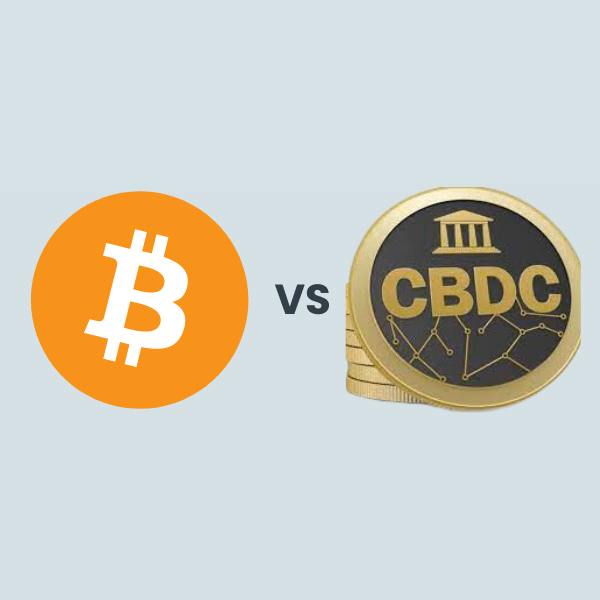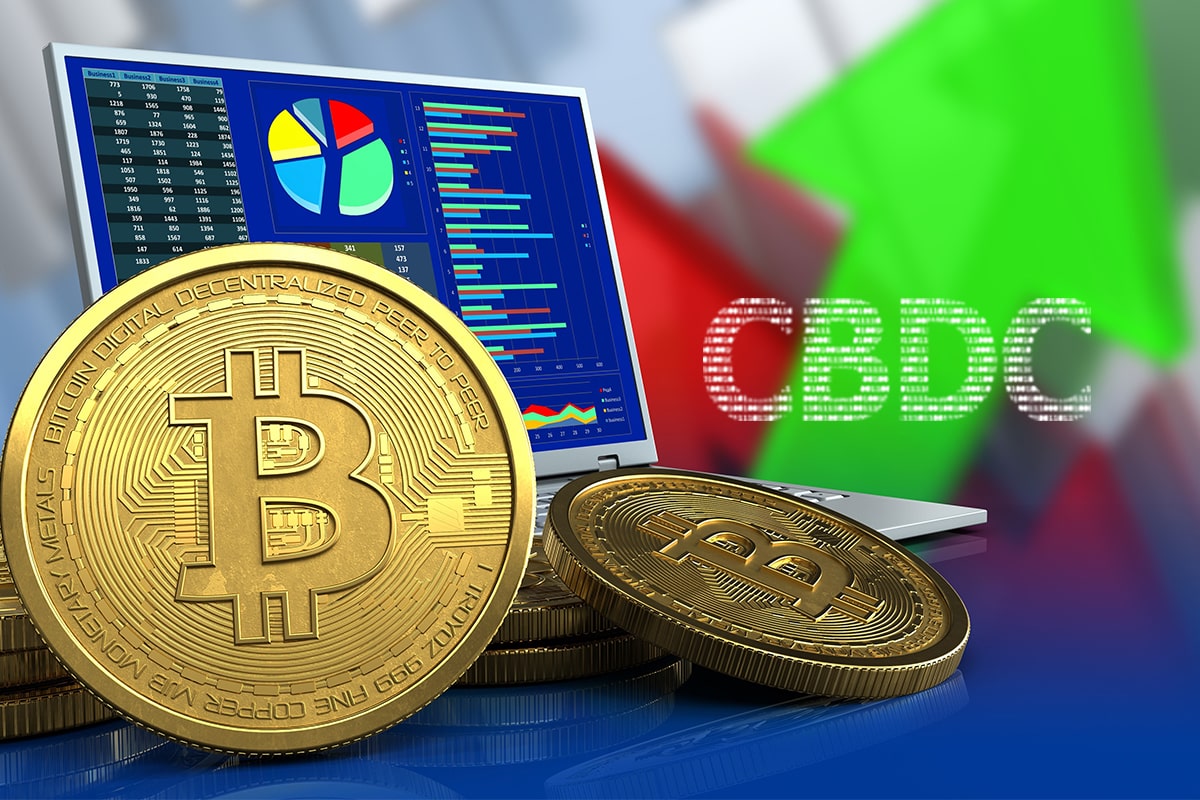You’ve heard about Bitcoin and Central Bank Digital Currencies (CBDCs), but you’re not quite sure how they stack up against each other.
You’re not alone.
With the rapid evolution of the digital currency landscape, it’s easy to get lost in the jargon and complex concepts.
But don’t worry, I’ve got you covered.
This article will summarize the key differences between Bitcoin and CBDCs.
Trust me, by the end of this read, you’ll have a clear understanding of what sets these two digital assets apart.
Let’s get started.
CBDC vs Bitcoin: Defined
Before we dive into the nitty-gritty differences, let’s first establish what exactly we’re talking about when we say “Bitcoin” and “CBDCs.”
Bitcoin Defined
In simple terms, Bitcoin is a decentralized digital currency that operates without a central authority or single administrator.
Created by an unknown person or group of people under the pseudonym Satoshi Nakamoto, Bitcoin was designed to be open-source and peer-to-peer.
This means that transactions take place directly between users without the need for intermediaries.
CBDCs Defined
Let’s talk about Central Bank Digital Currencies, or CBDCs for short.
Unlike Bitcoin, CBDCs are digital forms of a country’s existing national currency and are backed by that country’s central bank.
Think of it as a digital Dollar or Euro, fully regulated and governed by monetary policies.
So, you see, while both are digital currencies, they come from entirely different corners of the financial world.
Bitcoin is the rebel, challenging the traditional financial system, while CBDCs are the system’s digital evolution.
Got it?
Great, let’s move on to the more intricate differences.
Recommended read: Why are many crypto futures exchanges banned in USA?
Decentralization vs Centralization
Now that we’ve got the basics down let’s delve into one of the most fundamental differences between Bitcoin and CBDCs: the issue of centralization versus decentralization.
This is where things get interesting, so stay with me.
Decentralization in Bitcoin
One of the most captivating aspects of Bitcoin is its decentralized nature.
No single entity, government, or organization controls Bitcoin.
Instead, it operates on a peer-to-peer network maintained by a community of volunteers and nodes worldwide.
This decentralization offers freedom and autonomy that traditional currencies can’t match.
Centralization in CBDCs
On the flip side, we have CBDCs, the epitome of centralization.
Remember, CBDCs are issued by a country’s central bank, making them as centralized as possible.
Every transaction, every policy, and every aspect of the currency is under the direct control of a central authority.
This centralization allows for more structured monetary policies and easier regulation but comes at the cost of individual freedom and autonomy.
Want to trade Bitcoin safely? Check these SEC-Regulated Crypto exchanges
Monetary Policy Implications
How Bitcoin and CBDCs differ in monetary policy is a critical area that often gets overlooked, but it’s essential for understanding the broader impact of these currencies.
Let’s break it down.
Monetary Policy in Bitcoin
You might wonder, “Does Bitcoin even have a monetary policy?”
In a way, yes, it does.
But it’s not like anything you’ve seen before. Bitcoin’s monetary policy is algorithmic and predetermined.
The total supply is capped at 21 million coins, and new coins are introduced into the system at a decreasing rate through mining.
There’s no room for human intervention, which means no sudden changes in interest rates or money supply.
This fixed, transparent policy is one of Bitcoin’s selling points, offering predictability in an unpredictable world.
Monetary Policy in CBDCs
Unlike Bitcoin, the monetary policy for CBDCs is actively managed by the central bank of the issuing country.
This means the central bank can use the CBDC to implement various monetary policies, such as controlling inflation, managing interest rates, and stimulating economic growth.
The flexibility is there, but it also means that the currency’s value is subject to a centralized body’s decisions.
Security and Privacy
Ah, security and privacy—two of the most hot-button issues in digital currencies.
You’re asking the right questions if you wonder how Bitcoin and CBDCs stack up in these departments.
Let’s dive in.
Security in Bitcoin
Bitcoin uses cryptographic techniques to secure transactions, control the creation of new units, and secure the transfer of assets.
It operates on a decentralized network, making it resistant to censorship and fraud.
However, it’s worth noting that while the Bitcoin network itself is secure, individual users must take extra precautions to safeguard their private keys or their Bitcoin wallets.
Lose your key, and you lose your Bitcoins.
Simple as that.
Security in CBDCs
These digital currencies are issued by central banks, which means they come with a level of institutional trust and security.
CBDC transactions would likely go through a centralized system monitored and secured by the government.
This could make them less susceptible to individual theft but more open to government oversight and control.
Privacy Concerns
When it comes to privacy, Bitcoin offers a level of anonymity that CBDCs are unlikely to match.
Bitcoin transactions are pseudonymous, meaning they can be traced back to a digital address but not directly to an individual.
On the flip side, CBDCs, being government-issued, could be designed to be fully traceable, giving authorities the ability to monitor financial activities in real-time.
Accessibility and Inclusion
So, you’re curious about how accessible and inclusive these digital currencies are?
Great, because this is where the rubber meets the road.
Let’s break it down.
Accessibility in Bitcoin
One of the most compelling aspects of Bitcoin is its global accessibility.
You only need an internet connection and a digital wallet to start transacting.
No need for a bank account or credit history.
This opens financial possibilities for people in underbanked regions lacking traditional banking infrastructure.
However, the flip side is that Bitcoin’s steep learning curve could hinder non-tech-savvy individuals.
Accessibility in CBDCs
Central Bank Digital Currencies could be as accessible as physical cash, depending on their implementation.
In theory, CBDCs could be designed to work alongside traditional banking products, making them easily accessible to anyone with a bank account.
But here’s the catch: what about those without access to traditional banking?
While CBDCs could be engineered to be inclusive, there’s no guarantee they will be, especially if tied to existing financial institutions.
Recommended Read: Who regulates bitcoin & other cryptos in the US?
Financial Inclusion
Financial inclusion is a big deal, especially in developing economies.
Decentralized Bitcoin offers a form of financial inclusion that’s not tied to a central authority.
Anyone, regardless of their socio-economic status, can theoretically participate in the Bitcoin network.
CBDCs, if designed with inclusion in mind, could also offer a new way for people to engage with the financial system, but this would largely depend on the policies set by the issuing central bank.
Regulatory Landscape
Ah, the regulatory landscape.
Now, this is where things get interesting.
Regarding regulations, Bitcoin and Central Bank Digital Currencies (CBDCs) are worlds apart.
Let’s dive in.
Regulatory Oversight in Bitcoin
Bitcoin operates in a decentralized environment, meaning no central authority governs it.
This has its pros and cons.
On the one hand, it’s less susceptible to government interference, which many see as a plus.
But here’s the kicker: this lack of oversight makes it a hotbed for illegal activities like money laundering and tax evasion.
Various countries have taken steps to regulate Bitcoin to some extent, but it’s like the Wild West out there, with each jurisdiction setting its own rules. Like US considers Bitcoin as a legal tender while many other countries don’t.
Regulatory Framework for CBDCs
CBDCs are issued by central banks, which means they come with a full suite of regulatory oversight right out of the gate.
Think of it as the polar opposite of Bitcoin.
Every transaction could be monitored, and policies like Anti-Money Laundering (AML) and Know Your Customer (KYC) would be strictly enforced.
This level of regulation could make CBDCs more secure and less prone to illegal use, but it also means less privacy and freedom for the user.
The Balancing Act
The regulatory landscape for both Bitcoin and CBDCs is a balancing act between freedom and oversight.
Bitcoin offers more freedom but less oversight, making it riskier.
CBDCs offer more oversight but less freedom, potentially making them safer and more restrictive.
Future Trends and Predictions
Ready to peek into the future?
Let’s explore what’s on the horizon for both Bitcoin and CBDCs.
Trust me, you’ll want to pay close attention to this section.
Bitcoin’s Future Outlook
With its first-mover advantage, Bitcoin has already established itself as a store of value, akin to “digital gold”.
But here’s the thing: its future is still uncertain due to regulatory pressures and technological challenges.
Some experts predict that Bitcoin could either become a global reserve currency or face stringent regulations that could limit its growth.
It’s a high-risk, high-reward scenario.
CBDCs on the Rise
CBDCs are gaining traction fast.
Countries like China are already piloting their digital currencies, and others like the U.S. and the European Union are in the research phase.
The consensus?
CBDCs are coming, and they could reshape the global financial landscape.
They offer the promise of more efficient payment systems and greater financial inclusion.
But, and it’s a big deal, they also raise concerns about privacy and government control.
The Intersection of Both Worlds
Some experts believe that the rise of CBDCs could benefit Bitcoin.
How?
By normalizing digital currencies, CBDCs could make the general public more comfortable with the concept, thereby driving interest and investment into decentralized options like Bitcoin.
Conclusion
Ready to wrap this up?
Let’s summarize what we’ve learned and why it matters to you.
In the ever-evolving world of digital currencies, Bitcoin and Central Bank Digital Currencies (CBDCs) represent two sides of the same coin—pun intended.
While Bitcoin champions decentralization, offering freedom and privacy, CBDCs promise stability and regulation, albeit at the cost of central control.
The question isn’t necessarily which one will win out but how they will coexist and influence each other in the coming years.
As we’ve seen, the rise of CBDCs could potentially normalize digital currencies, making the general public more comfortable with decentralized options like Bitcoin.
On the flip side, the established presence of Bitcoin could push central banks to innovate and offer more features with their CBDCs.
So, what does this mean for you?
Whether you’re an Bitcoin investor, a tech enthusiast, or just someone keen on understanding the future of money, the landscape is shifting beneath your feet.
Understanding the nuances between Bitcoin and CBDCs can help you navigate this complex terrain and make informed decisions.
Ultimately, the coexistence of Bitcoin and CBDCs could lead to a more robust, diverse, and inclusive financial ecosystem.
And that’s something worth paying attention to.
There you have it.
We’ve demystified the complex world of Bitcoin and CBDCs, and hopefully, you’re walking away with a clearer understanding of what’s at stake.
Until next time!




